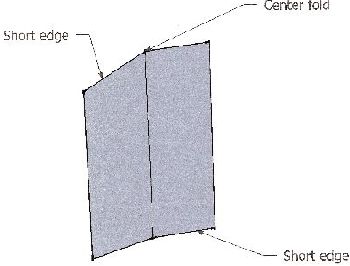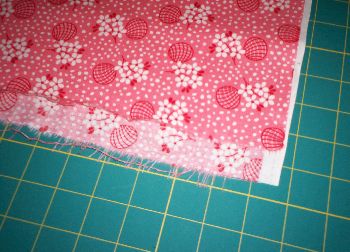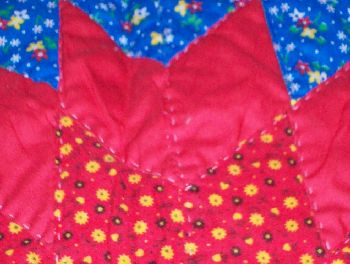In beginning this blog, I realized that I need to back track and talk about something I left out some time ago. You really need to straighten the fabric before you begin any project. That doesn’t include quilting alone. It includes any kind of sewing. Because of the nature of woven fabric, preparing the fabric edges will helpmake a better finished product.
To explain, let me remind you of that “screwy” pair of jeans that just feel out of kilter when you put them on. (Please stay with me. I’ll get to the quilt fabric soon.) If you try to iron them, you can’t get the legs to lie flat on the ironing board, no matter how hard you try. (Excuse me, I know that few people iron their clothes these days, but just imagine the situation if you can). Well, the problem is not all in your head, it’s because the fabric was not cut on the straight of the grain when it was being cut with two layers prior to sewing, actually, probably die-cut with dozens of layers. It also applies to that bed sheet or pillow case that youhate to use because you can’t get it to fold straight after laundering. The fabric was cut off the straight grain.
When woven fabric is torn, from selvage to selvage, the torn edge is across the natural cross grain of the fabric. However, when you purchase fabric, the two torn edges often do not meet. Scissor-cut fabrics are cut across the width, but not straight on the grain. The reason for this is that when many yards of fabric are rolled lengthwise on the bolt boards at the factory, the top layers shifts just a bit. In the process of rolling the fabric onto the boards, this shifting increases as the fabric is rolled, making the cut edges uneven.
So . . . when you cut out a pair of jeans or pants, that “shift” causes one leg to be cut slightly on the bias. This bias grain is what makes one pant-leg feel funny and the crease goes side ways, while the other lcrease is straight.
HOW TO STRAIGHTEN FABRIC
You will need a partner to help.
1. Grasp the fabric on the fold of the length and let the two selvage sides drape. If the torn (or cut) edge on both sides is the same length, you’re done. If not, go to step 2.
2. Each partner will have one side that is not as long as the other. Both partners grasp a short side (opposite corners) by the torn edge with both hands, back away, plant your feet and pull a steady strain (not jerk). Repeat step 1. If the sides are still not straight repeat step 2.

You can’t change those pant-legs, but when you sew on woven fabric, you can do a “fix” before you start to cut them out. This whole process doesn’t apply to just sewing pants. It is for any kind of apparel sewing. Whenever that fabric is not straightened, one layer of the fabric may be slightly on the bias, depending on how much the fabric is off grain. I have even had to buy more fabric at times, because the grain was asmuch as six inches off. I just recently learned my lesson again when I made a pair of pants, and didn’t straighten the fabric well enough. Those pants are a bother every time I iron them.
OK, now back to quilting fabric. Since you will not be sewing large pieces of fabric together, the straightening process is simpler. But it is still important. Even those small pieces in a quilt can make aquilt look wavy and bumpy, since there are bias pieces all over the surface of the quilt. The same is true for the large pieces of fabric used for the quilt backing. It needs to be cut straight to avoid a diagonal “pulled” look on the back of the quilt.
To get a straight edge at the beginning of a piece of fabric, use as large a surface as possible for the piece of yardage you work with. Lay the fabric out flat on the work surface. Lay the fabric with the selvage edges together, to your left, folded edges to the right. Pick up the selvage edges and bring them over and lay them evenly with the folded edge. Be sure the layers lie flat with the selvages and the folds even. There will probably be a difference in the cut edges that lie toward you. This is because the fabric was not cut straight. If the fabric is torn in the store, by the sales person, the edge will be straight on the cross grain.
When you observe the cut edges, you need to “square them up” with the selvage and folded edges. With the fabric laying this way, pick up the selvages and place them evenly on the fold line. Using long quilter’s ruler, 6 inches by 18 inches is good, lay the ruler across the cross grain, perpendicular to the selvages, with one of the inch lines on the ruler parallel with the selvage edges. With your rotary cutter, make a clean cut across the four layers of fabric. This becomes your starting point for cutting strips, etc for block pieces. Since the block pieces are small, it doesn’t matter if the cut pieces are just a bit off grain.



Triangles and diamonds are a different matter. With those, be sure that two edges of a right triangle are on the straight grain. With other triangles, make at least one edge on the straight grain. In making triangles, the bias is stretchy, so if all edges are on the bias, it will be a very unstable. With diamonds that have two parallel edges, make sure the two parallel edges are on the straight grain. If all edges are on the bias, the diamond will be unstable in all four directions. But with two parallel edges, only two edges are stable and two are on the bias. When sewn together, diamonds will often turn out with a straight edge sewn to a bias edge, which makes all edges of the pieces more stable. Try cutting some scrap diamonds and triangles.
Make some with all bias edges and some that have straight sides. Just play with them a bit, tugging gently on the edges, and you will see the results. Press bias edges carefully to avoid stretching the bias. I have a quilt that was given to me. It has bias edges on all four sides of the p diamonds. It’s a pretty quilt, but it has wavy and bumpy places all over.

I hope I have not confused you by these explanations. I learned the process of straightening fabric when I first began sewing in my teens. And I learned, may times over, that it is well worth the little extra time it takes to do it right.
Whew, I feel like I just made a whole quilt today. I have so many plans for quilts this year. I hope I can get at least a few of them done. This is a picture of the center block of a quilt that I need to sew together. I finished all the blocks several months ago, but I just haven’t put them all together. That’s another of my many UFO’S.

Please, if you decide to comment on this here, tell me where you live. It’s fun to imagine where you all live, even though I can’t imagine what you look like. Feel free to ask questions. I'll be glad to help if I can.
I hope you are all having a good winter, not too cold and snowy. It’s been cold in Alabama, but not compared to places farther to the north, and not as warm as Jan, our friend in Australia.
Stitches to you,
LaRue